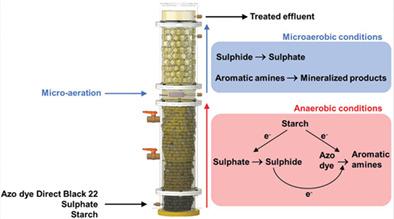当前位置:
X-MOL 学术
›
Can. J. Chem. Eng.
›
论文详情
Our official English website, www.x-mol.net, welcomes your feedback! (Note: you will need to create a separate account there.)
The influence of sulphate on the treatment of azo dye-containing wastewater in an anaerobic-microaerobic compartmentalized fixed-bed bioreactor
The Canadian Journal of Chemical Engineering ( IF 2.1 ) Pub Date : 2021-05-02 , DOI: 10.1002/cjce.24154 Marcelo G. P. Carvalho 1, 2 , Denise M. S. Marcelino 1 , Osmar Menezes 1 , Eugenio Foresti 3 , Marcia H. Z. Damianovic 3 , Mario T. Kato 1 , Lourdinha Florêncio 1 , Savia Gavazza 1
The Canadian Journal of Chemical Engineering ( IF 2.1 ) Pub Date : 2021-05-02 , DOI: 10.1002/cjce.24154 Marcelo G. P. Carvalho 1, 2 , Denise M. S. Marcelino 1 , Osmar Menezes 1 , Eugenio Foresti 3 , Marcia H. Z. Damianovic 3 , Mario T. Kato 1 , Lourdinha Florêncio 1 , Savia Gavazza 1
Affiliation

|
A fixed bed reactor (FBR) comprised of an anaerobic zone (AZ) coupled to a micro-aerated zone (MAZ) was used for the biological treatment of synthetic textile wastewater. The azo dye in the textile effluent is expected to be reduced to aromatic amines (decolouration) in AZ followed by biological degradation of the aromatic amines due to oxygen exposure in MAZ. We focused on assessing the effect of sulphate, a common component of textile wastewaters, on the degradation of the tetra-azo dye Direct Black 22 (DB22). The influence of sulphide, a product of sulphate biological reduction, on the removal of aromatic amines, toxic by-products of DB22 degradation, was also analyzed. The AZ and the MAZ were filled with expanded clay balls and polyurethane foam, respectively. The chemical oxygen demand and sulphate ratio (COD/SO4−2) in the feed started at 4.8 ± 0.2 and was later changed to 0.8 ± 0.1 by increasing the sulphate content. This change consequently increased DB22 removal efficiency from 38 ± 11% to 72 ± 6% in AZ and from 56 ± 7% to 75 ± 7% at MAZ, but also resulted in high sulphide concentration and reduced redox potential (ORP) at the MAZ inlet. However, the change negatively affected the degradation of aromatic amines in the MAZ. Aromatic amines were removed only at redox potential values higher than −228 mV and biogenic sulphide concentrations lower than 44 mg HS−/L.
中文翻译:

硫酸盐对厌氧-微好氧分隔固定床生物反应器处理含偶氮染料废水的影响
由与微曝气区 (MAZ) 耦合的厌氧区 (AZ) 组成的固定床反应器 (FBR) 用于合成纺织废水的生物处理。纺织品流出物中的偶氮染料预计会在 AZ 中还原为芳香胺(脱色),然后由于 MAZ 中的氧气暴露,芳香胺会生物降解。我们专注于评估硫酸盐(纺织废水的常见成分)对四偶氮染料 Direct Black 22 (DB22) 降解的影响。还分析了硫化物(硫酸盐生物还原产物)对去除芳香胺(DB22 降解的有毒副产物)的影响。AZ 和 MAZ 分别填充了膨胀粘土球和聚氨酯泡沫。化学需氧量和硫酸盐比(COD/SO 4-2 ) 在饲料中的起始值为 4.8 ± 0.2,后来通过增加硫酸盐含量变为 0.8 ± 0.1。因此,这种变化将 AZ 的 DB22 去除效率从 38 ± 11% 提高到 72 ± 6%,在 MAZ 从 56 ± 7% 提高到 75 ± 7%,但也导致 MAZ 的硫化物浓度高和氧化还原电位 (ORP) 降低进口。然而,这种变化对 MAZ 中芳香胺的降解产生了负面影响。芳香胺仅在高于 -228 mV 的氧化还原电位值和低于 44 mg HS - /L 的生物硫化物浓度下被去除。
更新日期:2021-05-02
中文翻译:

硫酸盐对厌氧-微好氧分隔固定床生物反应器处理含偶氮染料废水的影响
由与微曝气区 (MAZ) 耦合的厌氧区 (AZ) 组成的固定床反应器 (FBR) 用于合成纺织废水的生物处理。纺织品流出物中的偶氮染料预计会在 AZ 中还原为芳香胺(脱色),然后由于 MAZ 中的氧气暴露,芳香胺会生物降解。我们专注于评估硫酸盐(纺织废水的常见成分)对四偶氮染料 Direct Black 22 (DB22) 降解的影响。还分析了硫化物(硫酸盐生物还原产物)对去除芳香胺(DB22 降解的有毒副产物)的影响。AZ 和 MAZ 分别填充了膨胀粘土球和聚氨酯泡沫。化学需氧量和硫酸盐比(COD/SO 4-2 ) 在饲料中的起始值为 4.8 ± 0.2,后来通过增加硫酸盐含量变为 0.8 ± 0.1。因此,这种变化将 AZ 的 DB22 去除效率从 38 ± 11% 提高到 72 ± 6%,在 MAZ 从 56 ± 7% 提高到 75 ± 7%,但也导致 MAZ 的硫化物浓度高和氧化还原电位 (ORP) 降低进口。然而,这种变化对 MAZ 中芳香胺的降解产生了负面影响。芳香胺仅在高于 -228 mV 的氧化还原电位值和低于 44 mg HS - /L 的生物硫化物浓度下被去除。


























 京公网安备 11010802027423号
京公网安备 11010802027423号